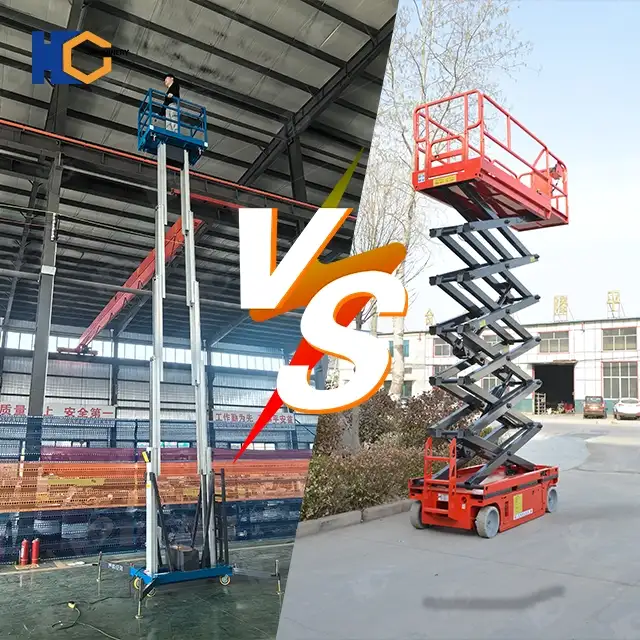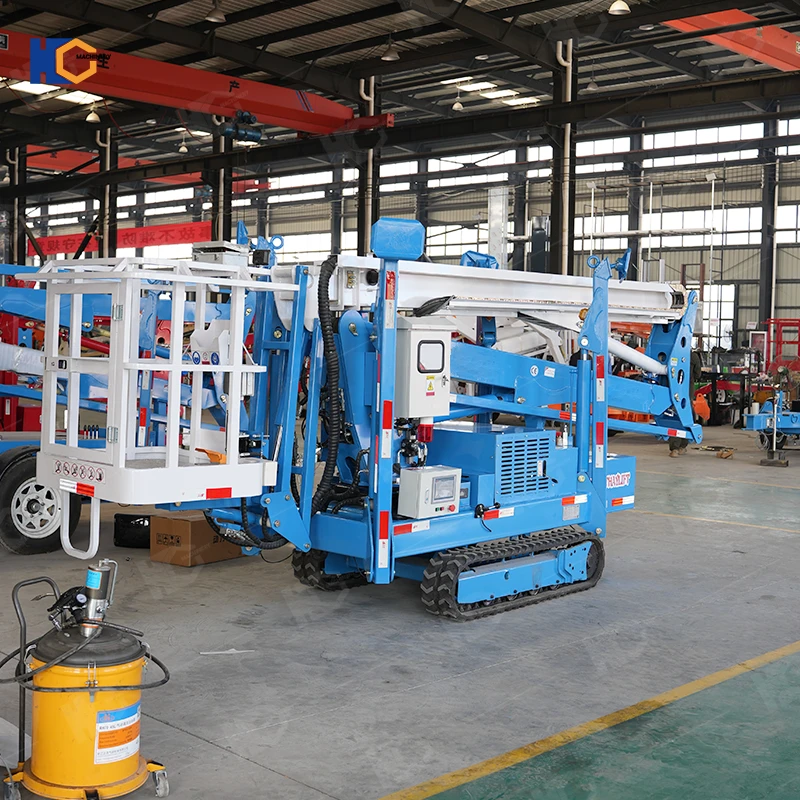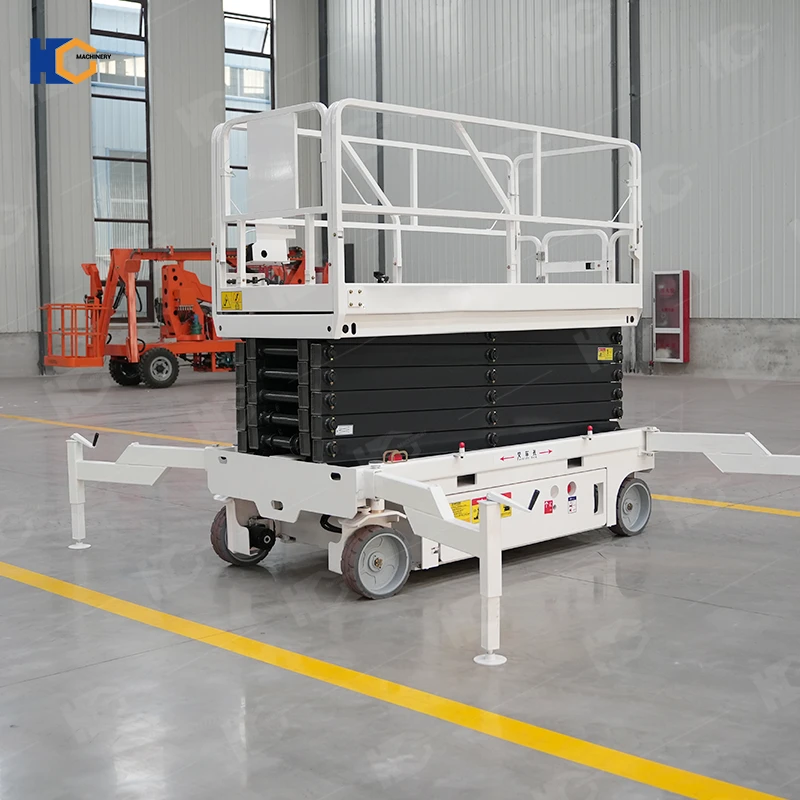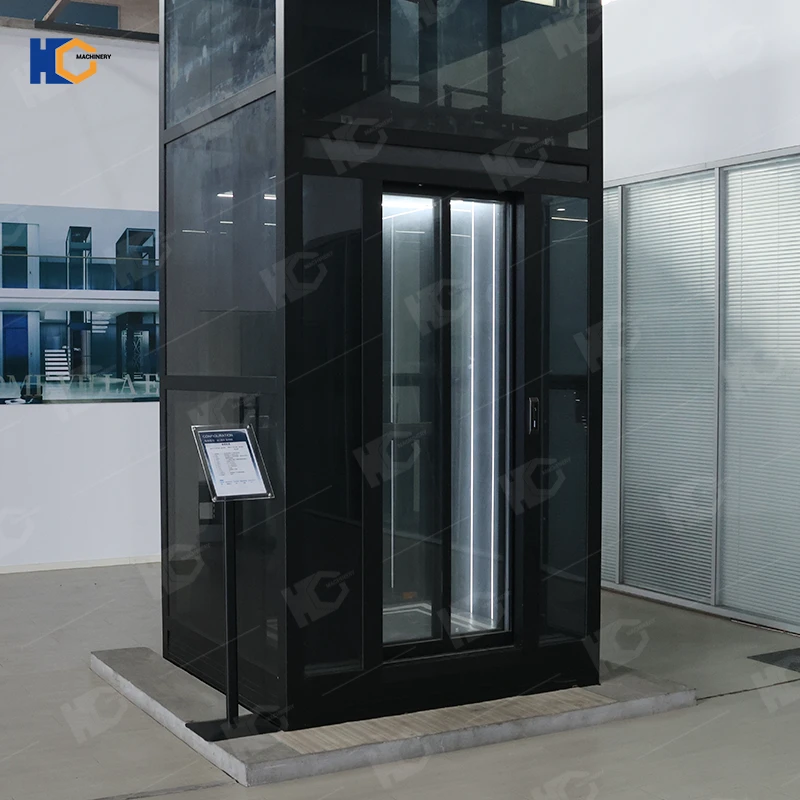Aerial Work Platforms (AWPs) are essential equipment for safely elevating workers and materials across industries like construction, warehousing, and facility maintenance. These machines come in various types, each designed for specific tasks, heights, and environments. Among the most common are push-around vertical mast lifts and scissor lifts, both offering unique advantages depending on the job requirements.
Choosing the right lift is critical for workplace safety, operational efficiency, and cost-effectiveness. The wrong equipment can lead to accidents, project delays, or unnecessary expenses. For example, a bulky scissor lift may struggle in tight indoor spaces, while a lightweight mast lift might lack the stability needed for outdoor construction. Factors like height requirements, workspace constraints, load capacity, and power source all play a role in determining the best solution.
This article provides a detailed comparison between push-around vertical mast lifts and scissor lifts, examining their pros, cons, and ideal applications. By the end, you’ll understand key differences in mobility, reach, stability, and cost, helping you make an informed decision for your next project. Whether you need a compact lift for indoor maintenance or a heavy-duty machine for outdoor use, this guide will point you in the right direction.
Overview of Push Around Vertical Mast Lifts
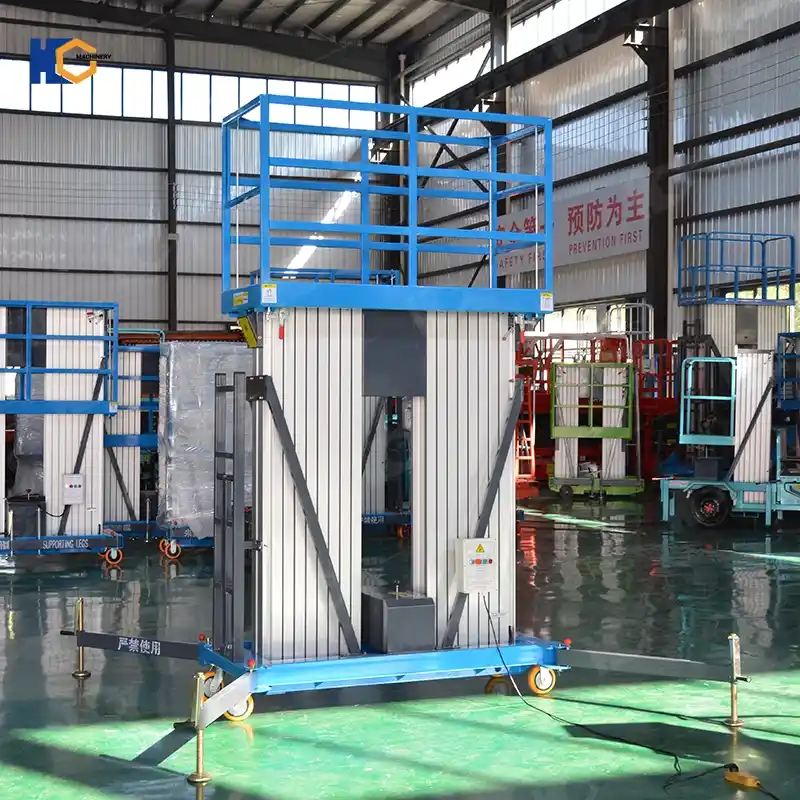
Push-around vertical mast lifts are a specialized category of aerial work platforms (AWPs) designed for compact, lightweight, and highly maneuverable operation in confined spaces. Unlike larger, motorized lifts, these units are typically manually propelled, meaning operators can easily push them into position without requiring an engine or complex controls. Their streamlined design makes them ideal for indoor applications where space is limited and floor load capacity may be restricted.
Design & Key Features
The defining characteristic of a push-around vertical mast lift is its vertical mast mechanism, which allows the platform to extend upward while maintaining a narrow footprint. This design offers several advantages:
Compact Base: The chassis is significantly smaller than that of a scissor lift, allowing it to fit through standard doorways (often as narrow as 30–36 inches) and operate in tight aisles.
Low Weight: Many models weigh less than 1,000 lbs, making them suitable for facilities with weight-sensitive flooring (e.g., warehouses, retail stores).
Manual Movement: Operators can reposition the lift without powered drive systems, reducing maintenance needs and improving accessibility in cluttered environments.
Non-marking Tires: Often equipped with polyurethane or rubber tires to prevent floor damage, a critical feature for indoor use.
Electric or Battery-Powered: Most modern mast lifts use electric motors for quiet, emission-free operation, making them safe for indoor air quality.
Typical Applications
Push-around vertical mast lifts excel in scenarios where larger equipment would be impractical. Common uses include:
Warehouse Maintenance: Replacing light fixtures, accessing high shelving, or performing HVAC repairs in narrow aisles.
Electrical & Plumbing Work: Safely servicing ceiling-mounted wiring, sprinkler systems, or ductwork in commercial buildings.
Retail & Hospitality: Decorating, signage installation, or cleaning in stores, hotels, and event venues with limited space.
Low-Clearance Indoor Sites: Working under mezzanines or in facilities with height restrictions where traditional lifts cannot fit.
Advantages Over Other Lifts
Compared to scissor lifts or boom lifts, push-around mast lifts offer:
Superior maneuverability in tight spaces.
Lower cost (both initial purchase and maintenance).
Easier transport (some models are lightweight enough for pickup truck loading).
Minimal setup time (no outriggers or stabilizers needed).
However, they do have limitations—such as lower weight capacities (typically 250–500 lbs) and limited outdoor use—making them unsuitable for heavy-duty construction or rough terrain.
By understanding these features and applications, businesses can determine whether a push-around vertical mast lift is the right solution for their elevated work needs.
Overview of Scissor Lifts
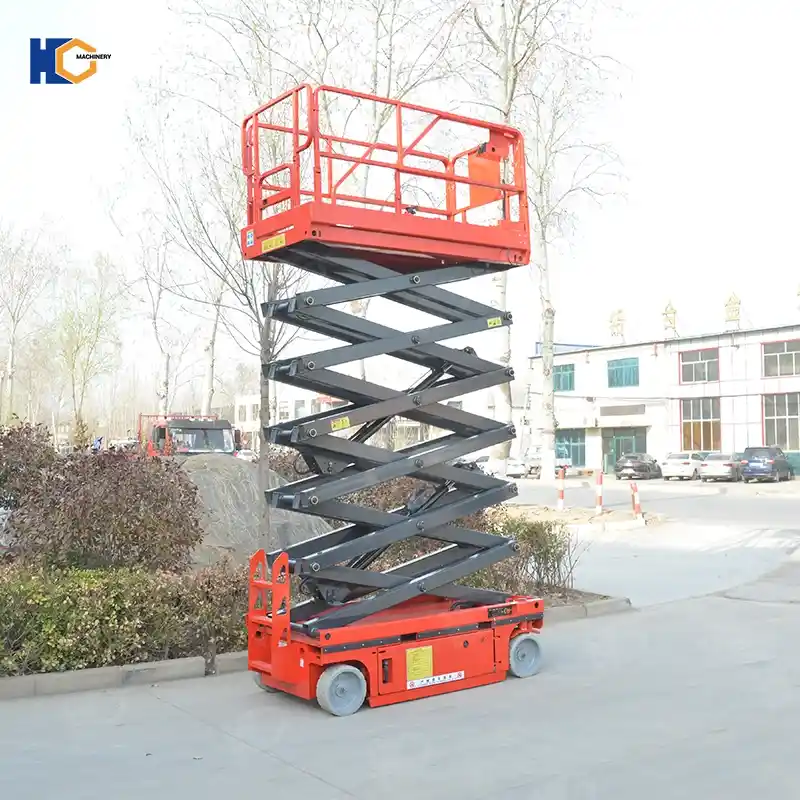
Scissor lifts are among the most widely used aerial work platforms (AWPs), recognized for their stability, large work platforms, and versatile lifting capabilities. Unlike vertical mast lifts, which rely on a single telescoping mast, scissor lifts use a crisscrossing "scissor" mechanism to elevate the platform vertically. This design provides a more stable base, making them ideal for tasks requiring heavy loads, outdoor use, or extended work durations at height.
Design & Key Features
Scissor lifts are engineered for durability and performance, with several defining characteristics:
Wider Base & Greater Stability: The scissor mechanism expands outward as the platform rises, creating a balanced, rigid structure that minimizes sway—critical for tasks requiring precision or heavy tools.
Higher Weight Capacity: Most scissor lifts support 500–1,500 lbs, accommodating multiple workers, tools, and materials (unlike lighter mast lifts).
Powered Movement: Equipped with electric, diesel, or hybrid engines, allowing self-propelled operation (unlike push-around mast lifts). Some models feature rough-terrain tires for outdoor job sites.
Larger Platform Space: Provides ample room for workers to move freely, store equipment, or handle bulky materials.
Adjustable Height Options: Ranges vary from 10–50 feet, catering to both low-level indoor tasks and mid-rise outdoor projects.
Typical Applications
Scissor lifts are the go-to choice for heavy-duty and large-scale projects, including:
Construction Sites: Facilitating exterior work like bricklaying, steel framing, or façade repairs where stability and load capacity matter.
Outdoor Maintenance: Installing signage, repairing streetlights, or servicing power lines in open or uneven terrain.
Industrial Facilities: Assembly line maintenance, machinery servicing, or warehouse operations requiring longer work durations at height.
Event Setup: Rigging stages, lighting, or decorations in arenas and concert venues where platform space is essential.
Advantages Over Other Lifts
Compared to vertical mast lifts, scissor lifts offer:
Superior stability for heavy loads and outdoor use.
Greater versatility (electric for indoors, diesel for rough terrain).
Faster horizontal movement (self-propelled models save time).
Better suitability for prolonged tasks (larger platforms reduce fatigue).
However, their larger size limits use in tight spaces, and higher costs (purchase, fuel, and maintenance) may not justify their use for small-scale indoor jobs.
Key Comparison Factors: Push Around Vertical Mast Lifts vs. Scissor Lifts
When selecting between push-around vertical mast lifts and scissor lifts, five critical factors determine which equipment best suits your needs: height requirements, mobility, stability, power source, and cost. This detailed 600-word comparison examines each aspect to help you make an informed decision.
(A) Height & Reach Capabilities
Vertical mast lifts specialize in low-to-mid height applications, typically ranging from 10 to 30 feet. Their compact design excels in environments with vertical space constraints, such as warehouses with low ceilings or narrow aisles. The vertical mast mechanism allows for precise positioning in tight spaces where other lifts cannot operate.
Scissor lifts dominate in applications requiring 20 to 50 feet of reach. Their scissor mechanism provides superior extension capabilities, making them ideal for construction sites, exterior building maintenance, and industrial facilities with high ceilings. The larger platform accommodates more workers and materials at these elevated heights.
(B) Mobility & Maneuverability
Push-around vertical mast lifts are the undisputed champions of confined space maneuverability. Weighing as little as 800 pounds, these units feature:
Manual propulsion (no need for powered drives)
Narrow chassis designs (as slim as 30 inches wide)
Zero-turn capabilities in tight spaces
Lightweight construction for easy transport between job sites
Scissor lifts require more operating space due to their:
Wider base dimensions (typically 4-6 feet wide)
Self-propelled systems needing clearance for movement
Heavier frames (often 3,000+ pounds)
Outrigger requirements on some models for stabilization
However, modern rough-terrain scissor lifts offer exceptional outdoor mobility with:
4WD capabilities
All-terrain tires
Articulating axles for uneven ground
(C) Stability & Load Capacity
Vertical mast lifts prioritize compactness over load capacity, featuring:
250-500 lb weight limits (ideal for 1-2 workers with light tools)
Narrow base stability systems (suited for flat, indoor surfaces)
Lower platform railings to maintain clearance in tight spaces
Scissor lifts provide industrial-grade stability with:
500-1,500 lb capacity (multiple workers with heavy equipment)
Wide, reinforced platforms for material handling
Automatic leveling systems on rough-terrain models
Integrated guardrails for enhanced fall protection
(D) Power Source & Environmental Suitability
Vertical mast lifts operate almost exclusively as:
Electric/battery-powered units
Emission-free operation for indoor air quality
Quiet performance (under 70 dB)
Limited to smooth, flat surfaces
Scissor lifts offer multiple power configurations:
Electric Models:
Indoor use
Zero emissions
Limited run times (4-8 hours)
Diesel/Hybrid Models:
Outdoor/rough terrain capability
Extended operation
Higher noise levels (85+ dB)
Bi-Energy Systems:
Electric operation indoors
Diesel power for outdoor transition
(E) Cost & Maintenance Considerations
Vertical Mast Lifts present a budget-friendly option:
Purchase Price: 8,000−8,000−15,000
Maintenance Costs: 500−500−1,000 annually
Battery Replacement: Every 3-5 years (500−500−1,500)
Advantages: Fewer moving parts, no hydraulic fluids, simple electrical systems
Scissor Lifts require greater investment:
Purchase Price: 15,000−15,000−50,000+
Maintenance Costs: 2,000−2,000−5,000 annually
Engine/Hydraulic Service: Regular fluid changes and component inspections
Advantages: Longer service life, higher resale value, multifunctional use
The total cost of ownership varies significantly based on:
Usage frequency (occasional vs. daily operation)
Operating environment (harsh conditions increase maintenance)
Operator training requirements
Rental availability for temporary needs
Decision-Making Summary
Choose a vertical mast lift when:
Working in confined indoor spaces
Budget constraints exist
Tasks require frequent repositioning
Low-weight applications suffice
Opt for a scissor lift when:
Outdoor/rough terrain operation is needed
Projects demand higher weight capacities
Extended platform time is required
Versatility justifies higher costs
This comprehensive comparison demonstrates how each lift type serves distinct purposes across industries. Proper equipment selection improves safety, productivity, and cost-efficiency for elevated work applications.
Pros & Cons Summary
| Factor | Push Around Vertical Mast Lift | Scissor Lift |
|---|---|---|
| Space Efficiency | ✅ Extremely compact | ❌ Needs more room |
| Outdoor Use | ❌ Limited | ✅ Yes (diesel models) |
| Load Capacity | ❌ Lower | ✅ Higher |
| Cost | ✅ Affordable | ❌ More expensive |
Which One Should You Choose? Making the Right Lift Selection
Selecting between a push-around vertical mast lift and a scissor lift depends entirely on your specific work environment, budget, and operational requirements. Here's a detailed 400-word guide to help you make the optimal choice:
When to Choose a Push-Around Vertical Mast Lift
Space-Constrained Indoor Applications
Perfect for warehouses with narrow aisles (as slim as 30" clearance)
Ideal for retail stores, convention centers, and facilities with low ceilings
Can navigate through standard doorways (unlike most scissor lifts)
Budget-Conscious Operations
Lower initial investment (typically 40-60% cheaper than comparable scissor lifts)
Reduced maintenance costs (no hydraulic systems, simpler mechanics)
No fuel expenses (electric operation)
Frequent Repositioning Needs
Lightweight design (often under 1,000 lbs) allows easy manual movement
Instant setup with no stabilizers required
Enables quick transitions between multiple work points
Specialized Indoor Requirements
Non-marking tires protect delicate flooring
Quiet operation (under 70 dB) for noise-sensitive environments
Zero emissions for indoor air quality compliance
When to Choose a Scissor Lift
Outdoor or Rough Terrain Applications
Diesel models handle uneven construction sites
All-terrain tires and 4WD options available
Weather-resistant components for outdoor durability
Heavy-Duty Work Requirements
Higher load capacities (up to 1,500 lbs vs. 500 lbs for mast lifts)
Larger platforms (20-40 sq ft vs. 8-12 sq ft) for multiple workers
Ability to handle bulky materials/tools
Extended Height Operations
Reach up to 50+ feet (vs. 30' max for mast lifts)
More stable at greater heights due to wider base
OSHA-compliant guardrails for elevated work safety
Prolonged Work Sessions
Comfortable space for full-shift operations
Some models feature weather canopies
Reduced worker fatigue due to stable platform
Hybrid Solutions
For operations needing both lift types:
Consider renting specialty equipment for unique projects
Some manufacturers offer compact electric scissor lifts for indoor/outdoor crossover use
Evaluate total cost of ownership vs. rental options for occasional needs
Final Recommendation:
Conduct a thorough site assessment measuring:
✓ Available workspace dimensions
✓ Required working height
✓ Weight capacity needs
✓ Power source availability
✓ Budget constraints
This analysis will clearly indicate whether the space-efficient vertical mast lift or the heavy-duty scissor lift better serves your operational requirements. Many facilities ultimately benefit from having both types available for different applications.
Safety Considerations for Vertical Mast Lifts and Scissor Lifts
Proper safety protocols are critical when operating aerial work platforms. While both vertical mast lifts and scissor lifts improve work efficiency, they present unique hazards that require specific precautions.
Push-Around Vertical Mast Lift Safety
Operator Training
Requires certification for manual movement and height adjustment
Workers must understand load limits (typically 250–500 lbs)
Training should cover emergency lowering procedures
Movement & Positioning
Always push (never pull) the lift to maintain control
Lock casters before elevating the platform
Avoid sudden movements that could destabilize the mast
Environmental Hazards
Never use on inclines exceeding manufacturer specifications (usually 3–5°)
Keep clear of overhead obstructions when raising the mast
Ensure floor can support the lift's weight (check load capacity ratings)
Fall Protection
OSHA requires harnesses when guardrails don't meet height requirements
Maintain three points of contact when entering/exiting
Scissor Lift Safety
Stabilization
Deploy outriggers on uneven surfaces (if equipped)
Use leveling pads on soft ground
Never exceed 10° slope unless designed for rough terrain
Load Management
Verify weight distribution before elevation
Keep materials centered on the platform
Never use guardrails as anchor points
Movement Hazards
Look in the direction of travel when driving
Maintain 10+ ft clearance from electrical hazards
Lower platform completely before relocating
Environmental Factors
Check wind speeds (max 28 mph for most models)
Use dielectric models near live electricity
Avoid muddy or icy conditions that affect traction
General Safety Practices for Both Lifts:
✔ Conduct pre-operation inspections (controls, brakes, hydraulics)
✔ Wear hard hats and high-visibility vests
✔ Never modify or bypass safety devices
✔ Establish fall zones with warning tape
Proper training, equipment maintenance, and hazard awareness prevent most aerial lift accidents. Always consult OSHA 1926.453 and manufacturer guidelines for specific requirements.
Conclusion: Choosing the Right Lift for Your Needs
When deciding between a push-around vertical mast lift and a scissor lift, the key differences come down to space, height, capacity, and environment:
Vertical Mast Lifts excel in tight indoor spaces, offering lightweight maneuverability and cost efficiency for low-to-mid height tasks (10–30 ft).
Scissor Lifts provide greater stability, higher reach (up to 50 ft), and rugged outdoor performance, making them ideal for construction, heavy-duty work, and rough terrain.
The right choice depends on your specific project requirements:
✔ Need to work in narrow aisles or low-clearance areas? → Choose a vertical mast lift.
✔ Handling heavy materials or working outdoors? → A scissor lift is the better option.
✔ Balancing budget and functionality? → Consider rental options or hybrid models.
We Can Help You Find the Perfect Lift!
As a leading lift manufacturer in China, we supply high-quality push-around vertical mast lifts and scissor lifts for all industries. Whether you need:
Compact electric lifts for warehouses
Heavy-duty diesel scissor lifts for construction
Customized solutions for specialized applications
Our experts can guide you in selecting the safest, most efficient, and cost-effective aerial work platform for your needs.
Contact us today for a free consultation!
Email: admin@jnhclift.com
Website: https://www.jnhclift.com/
Let us help you elevate your productivity with the right equipment!
